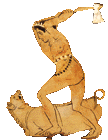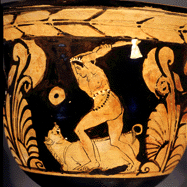

The wealthy had the leisure time to hunt wild game with hounds, nets and traps, or to chase on horseback deer and wild boar. While Xenophon describes hunting lions, leopards, lynxes and bears in the mountainous regions of northern Greece and southeastern Turkey, it is unlikely that the Greek countryside supported much in the way of large game.
|
|
Attic
Geometric Kantharos |
|
Attic Red Figure Askos |
|

Campanian Red Figure Bell Krater
Late 5th century BC
By the Cassandra Painter or his circle
MS 5687 detail
A somewhat unorthodox hunting scene, perhaps depicting a legendary
event in which a young man slays a boar with his ax.
Photo courtesy Mediterranean Section, Univ. of Pennsylvania Museum
(larger
version)